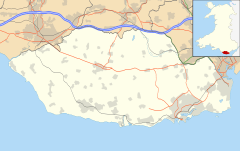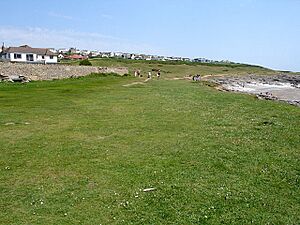Ogmore-by-Sea facts for kids
Quick facts for kids Ogmore-by-Sea
|
|
|---|---|
Ogmore-by-Sea at sunset |
|
| Population | 878 |
| Community |
|
| Principal area |
|
| Ceremonial county | |
| Country | Wales |
| Sovereign state | United Kingdom |
| Post town | BRIDGEND |
| Postcode district | CF32 |
| Dialling code | 01656 |
| Police | South Wales |
| Fire | South Wales |
| Ambulance | Welsh |
| EU Parliament | Wales |
| UK Parliament |
|
| Welsh Assembly |
|
Ogmore-by-Sea (in Welsh: Aberogwr, meaning "Mouth of the River Ogmore") is a small village by the sea in the Vale of Glamorgan, Wales. It's part of the St Brides Major community. This village sits at the western edge of the beautiful Glamorgan Heritage Coast in south Wales. In 2011, about 878 people lived here.
Contents
A Look Back at Ogmore-by-Sea's Past
A very old, polished stone axe-head was found near Ogmore Mill in 1976. This axe-head was a special type called "Seamer." It shows that people lived in this area a very long time ago.
Shipwrecks and Legends
The beach and coast here face west, just like places in Cornwall, Ireland, and Brittany. This made it a dangerous spot for ships when strong winds blew from the Atlantic Ocean. Many ships were wrecked, especially on Tusker Rock. This is a dangerous reef slightly out at sea that gets completely covered when the tide is high.
There are old stories about people purposely causing shipwrecks at Ogmore. These tales suggest people might have used fake lights to trick ships. They would make a light flicker, hoping ships would think it was a lighthouse or another ship. This would lure them closer to the shore and cause them to crash. However, there is no real proof that these stories are true.
The Village Church
In 1954, a church group started meeting in one of the houses in the village. The group grew bigger over time. In 1968, a special building was built for them to meet in. The church is still active today and uses the same building. In 2018, they celebrated their 50th anniversary!
Exploring Ogmore-by-Sea's Landscape
Ogmore-by-Sea is about 3 miles (5 km) south of Bridgend. It is also about 20 miles (32 km) west of Cardiff. The beaches here look out towards Tusker Rock. When the tide is low, you can see sand. But when the tide is high, the beach becomes very rocky.
The River Ogmore Estuary
The River Ogmore flows into the sea here, forming an estuary. On one side of the estuary is Ogmore beach. On the other side are the large sand dunes of Merthyr Mawr. Because of the river's currents, it is not safe to swim in most parts of the beach.
The rocky shoreline is a popular spot for rock climbing. It's also a great place to explore if you are interested in geology. You can see many different kinds of fossils clearly in the rocks. Many visitors park their cars near the estuary. Others drive further along to Southerndown.
Hidden Bays and Caves
Ogmore has several beaches. If you follow the path from the car park, you will find Hardee's Bay and Horseshoe Bay. Further along, below Brig Y Don hill, there are deeper areas with caves and quiet coves. Many of these hidden spots can only be reached when the tide is low.
The Amazing Rocks of Ogmore-by-Sea
The rocks you can see along the coast near Ogmore-by-Sea are very old. They were formed between 340 and 195 million years ago! These are all sedimentary rocks. This means they were made from layers of lime, mud, sand, and pebbles that settled over time. Over millions of years, these layers were pressed and hardened into limestone, shale, and conglomerate.
Ancient Seas and Deserts
The oldest rocks here are hard, grey limestones. These are called Carboniferous Limestone. They formed in a warm, shallow, subtropical sea. These rocks are full of fossils, especially corals, crinoids (sea lilies), and brachiopods (shellfish).
About 300 million years ago, the Earth's crust moved. This caused the rocks to bend and fold. The rocks that were above the Carboniferous Limestone wore away. Then, during the Triassic Period, new layers began to form. At this time, the area was a desert with limestone hills. The place where the Bristol Channel is now was a dry plain.
Short, strong storms would cause sudden floods. These floods carried rocks and dirt down the hills. They left behind piles of coarse, red conglomerate at the edge of the plain. These Triassic rocks lie directly on top of the older Carboniferous Limestone. This is called an "unconformity," meaning there's a gap in the rock record.
The Return of the Sea
Around 205 million years ago, at the start of the Jurassic Period, the sea began to cover the land again. The limestone hills became islands before they were completely covered by water. The Sutton Stone, which has pebbles of carboniferous limestone, shows rocks that formed close to the shore of these islands. In deeper water, the Southerndown Beds were laid down. Finally, when the whole area was covered by deep water, layers of limestone and shale called the Blue Lias were formed.
After the early Jurassic period, we don't have much rock evidence of what happened until about 10,000 years ago. This was after the last ice age. The sea levels changed a lot as the ice sheets grew and melted. This shaped the landscape we see today. The coastline is still being changed by the wind, rain, and waves.
Cool Places to See
The Ogmore centre was built in the 1930s. It was made for children from all over South Wales to visit. It closed in the mid-1990s but reopened as a Trust in 1998. It continued to operate until 2007. Nearby, you can also find the Southerndown Golf Club and Portobello House.
Ogmore-by-Sea in Books and Songs
- The Cardiff band Doofer mentions "Ogmore-by-the-Sea" in their song "Don't get along with me Babe."
- Dannie Abse (1923–2014) was a poet born in Cardiff. He wrote several poems that mention or are about "Ogmore-by-Sea" and the surrounding countryside in South Wales.
- Ogmore-By-The-Sea is the home of Lucy Wilson and her friend, Hobo, in 'The Lucy Wilson Mysteries'. These are a series of books published by Candy Jar Books. They are connected to the BBC show 'Doctor Who'.
See also
 In Spanish: Ogmore-by-Sea para niños
In Spanish: Ogmore-by-Sea para niños




